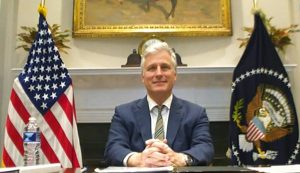In Southeast Asia, it is often said, a large part of diplomacy is simply showing up – something that the current U.S. administration seems never quite to have grasped.
Over the weekend, President Donald Trump once again skipped a series of high-level summits with his Asian counterparts, a decision that is set to reinforce long-standing concerns about Washington’s reliability as a regional partner.
This is the third year in a row that Trump failed to show up for the annual summit of the Association of Southeast Asian Nations (ASEAN) and its cluster of related meetings, which were this year held via video link due to the ongoing coronavirus pandemic. For the second year in a row, the U.S. was represented by National Security Adviser Robert O’Brien, the lowest level representation since 2011.
During the annual ASEAN-U.S. Summit, held via video link on November 14, O’Brien expressed regret for Trump’s absence, but hailed the importance of the region for Washington. “At this time of global crisis, the U.S.-ASEAN strategic partnership has become even more important as we work together to combat the coronavirus,” he said during the event’s opening ceremony. The following day, O’Brien attended the East Asia Summit (EAS), which included leaders from the 10 ASEAN states as well as Australia, China, India, Japan, South Korea, New Zealand, and Russia.
While Trump’s personal appearance at these meetings was not expected (nor, frankly, desired), the fact that he was not represented by Secretary of State Mike Pompeo or Vice President Mike Pence – who occupy the next two spots in the diplomatic pecking order – has once again signaled to ASEAN that, rhetoric to the contrary, the region is a low priority for the current administration.
While Trump attended the U.S.-ASEAN summit in Manila in 2017, he has never attended a full EAS. Pence represented the U.S. at the meetings in Singapore in 2018, while O’Brien did so in Thailand last year. On the latter occasion, Southeast Asian nations were so put out by the low-level delegation that they snubbed the U.S. by downgrading their own delegations to the ASEAN-U.S. Summit. Leaders from just three nations – Thailand, Laos, and Vietnam – attended.
This weekend, a similar snub occurred with just five of the region’s 10 heads of government appearing. These included leaders from the so-called “troika”: Thailand (which held ASEAN’s rotating chairmanship last year), Vietnam (the present chair), and Brunei (next year’s chair), as well as from Singapore and Laos. Prime Minister Hun Sen of Cambodia was also absent due to his quarantine for COVID-19. By comparison, President Barack Obama failed to attend the annual summits just once during his eight years in office.
The low-level representation was all the more glaring as China entrenched its influence in the region with the signing of the massive Regional Comprehensive Economic Partnership (RCEP) on November 15. Uniting the 10 nations of ASEAN plus Japan, China, South Korea, Australia, and New Zealand, RCEP will encompass a third of the global economy – possibly more, if India joins at a later date. As I have argued elsewhere, the creation of the RCEP has cast Trump’s administration to withdraw from the U.S.-led Trans-Pacific Partnership as an increasingly fateful decision – one that now leaves the U.S. languishing outside Asia’s two major free trade zones.
The low-level American delegation is another sign of the incoherence and inconstancy of the Trump’s administration’s foreign policy. While the administration has designated Southeast Asia as a priority focus of its Free and Open Indo-Pacific strategy, it has riled local partners by picking petty trade disputes and failing to clock face-time at important regional summits. This no-show is all the more baffling given the fact that the meetings took place online, so “showing up” required relatively scant effort.
As Aaron Connelly of Singapore’s International Institute for Strategic Studies put it on Twitter, “That the lame duck Trump administration couldn’t even do better in a virtual format will seal its legacy in Southeast Asia as one of institutional disengagement.”
What the incoming Biden administration will bring remains to be seen, but it, too, is likely to introduce its own share of tensions and contradictions into its relationship with ASEAN and its member-states.
Despite its volatile swings and inconsistencies, the Trump administration has not been wholly unpopular in Southeast Asia. While the region’s governments have had little time for Pompeo’s ideological harangues and “with us or against us” position on competition with China, some regional partners have appreciated the fact that the United States is doing more to counterbalance Beijing’s security presence in the region. Meanwhile, Trump’s transactional approach to the region has been a welcome change from the self-righteous liberal evangelism of the Obama years.
Following Obama’s lead, President Biden will no doubt improve Washington’s high-level engagement with Southeast Asian partners, and inject a degree of constancy and level-headedness into its policy toward the quintessential “Indo-Pacific” region. But it is also likely to restore strands of Obama-era policy that created frictions in the region. In particular, Biden’s foreign policy team’s promise that it will once again distance the U.S. from undemocratic and illiberal governments is likely to reintroduce a degree of tension to key relationships in Southeast Asia, from Hanoi to Naypyidaw.
There are also fears that Biden could mark a return to Obama’s overly accommodating position toward China, especially on the question of the South China Sea. As James Crabtree wrote in September, the prospect of a Biden presidency “brings back uncomfortable memories of an Obama era that many Asian movers and shakers recall as unfocused and soft toward Beijing.”
As the Trump administration winds down, U.S. policy seems likely to trade out one set of tensions and contradictions for another.

































